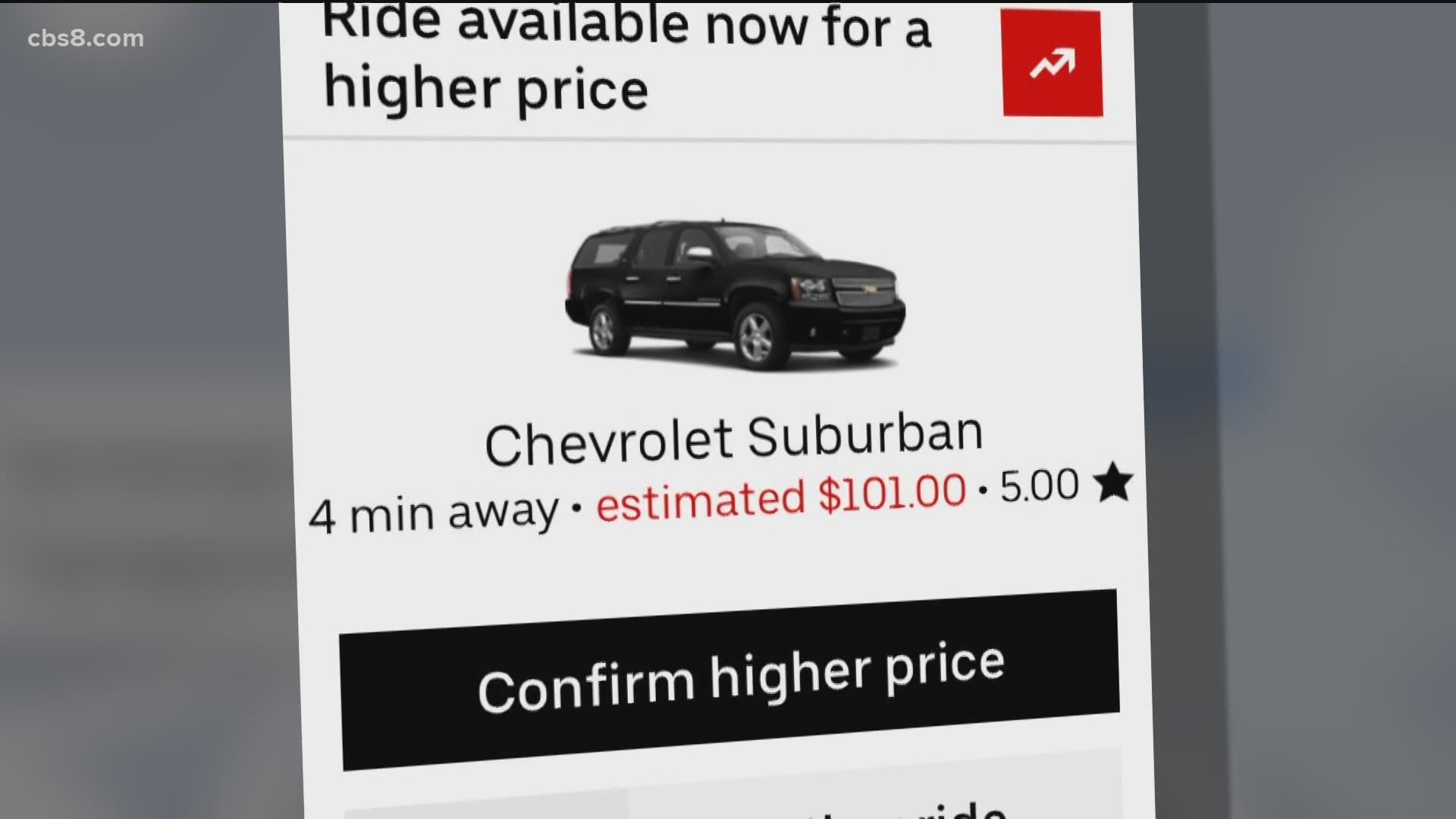SAN DIEGO — Rideshare customers complained of higher prices this Memorial Day weekend to get around town. News 8 viewers sent screenshots of quotes upwards of $100 from San Diego International Airport to Pacific Beach, about 10 miles.
Drivers said they have seen fares of several hundred dollars to go further into North County.
The major companies have said they are experiencing a driver shortage that began during the pandemic.
“A lot of drivers are mad at the fact that their rates have gone down and that’s why a lot of drivers prefer to go either on unemployment or not work for the company at all,” explained Chris Rios, who drives with Uber. “They told us that we would have a lot of flexibility, a lot of power to control how much earnings we were going to have and then all of a sudden Uber just took it away and that’s another big reason why drivers are mad and why they decided not to work.”
Previously, Uber allowed drivers to set prices. However, in April, the company began to set rates.
“Over the last year, rider cancellations have increased 117%. We’ve seen that most riders are simply not taking trips with fare multipliers above 1x or without an upfront price. As California reopens, we need to make changes so all drivers can get more trip requests and riders can count on getting a ride when they request one,” says Uber in a statement explaining the change.
Multiple drivers told News 8 the change makes longer rides less profitable or even a money loser. They also said they have been canceling more rides to further destinations, even as late as when the customer is about to enter their car because the app doesn’t always show where the passenger is going before they accept.
“I drove 134 miles [to Murrieta from San Diego]. If you calculate it, it’s 40 cents per mile and the IRS considers car expenses at 57.5 cents [per mile]. So, I was losing more than 17 cents per mile let alone the two hours I was driving,” said Jama Yacub, who started as a rideshare driver seven years ago. “Right now, in order to cover my expenses, we look for the surge. If there’s no surge, we don’t move because we’re losing money and time.”
During surges, customers must pay more for rides. However, drivers contend the set rates mean they only see a small share of the extra money customers are paying.
“They are taking more than 50% of what they take from the customer,” said Yacub. “This is not a fair game. This is not a win-win situation. It’s win-lose. They are winning, we are losing and the customers are losing.”
Other drivers said the high prices push customers away from app-based services and towards public transit or taxis.
“A lot of them are taking taxis, I’ve noticed, and they’re less interested in Uber because Uber tends to overcharge, especially during peak times and when it’s not busy then they underpay us so there’s no point for us to drive or go out of our way to pick somebody up,” said driver Yuriy, who declined to give his last name. “If it’s outside the radius of the airport we get cut down to 35 cents a mile and 30 cents per minute so to us drivers it’s not worth it to drive far.”
Instead, drivers try to stay close to Downtown or the beach communities where rides tend to be shorter, which also prompts the app-based services to give them additional compensation.
Uber CEO Dara Khosrowshahi acknowledged the company is working to increase driver supply. Uber pointed to a $250 million driver stimulus effort it announced last month in a bid to get drivers back on the road.
"Boosted incentives and guarantees will help welcome existing drivers back to Uber and ensure first-time drivers do well as they learn the ropes," says Uber's statement on the stimulus. "In 2020, many drivers stopped driving because they couldn’t count on getting enough trips to make it worth their time. In 2021, there are more riders requesting trips than there are drivers available to give them—making it a great time to be a driver."
Most drivers who spoke with News 8 said they were not satisfied with the incentives and want to be able to set their own fares again. Although only a few acknowledged they are planning to stop driving soon.
“Gotta pay the bills, right? My strategy is I stay close to downtown, P.B. and the airport. If I get somebody that needs to go far, I’m canceling the ride. It’s business,” said Yuriy.
Other drivers said they were happy with the changes and plan to stay on the road.
“I like my job. I make good money for myself. I’m fine and dandy with what I take at the end of the day. It’s all about how many hours you put into the job and how much you’re willing to work,” said Rios. “I still make a lot more money than a lot of people out there with a 9 to 5 job for me. For me, honestly, it’s just keep on working. Keep on working, keep getting those rides. I’ll make my money. I’ll make my quota but that’s my personal opinion."

